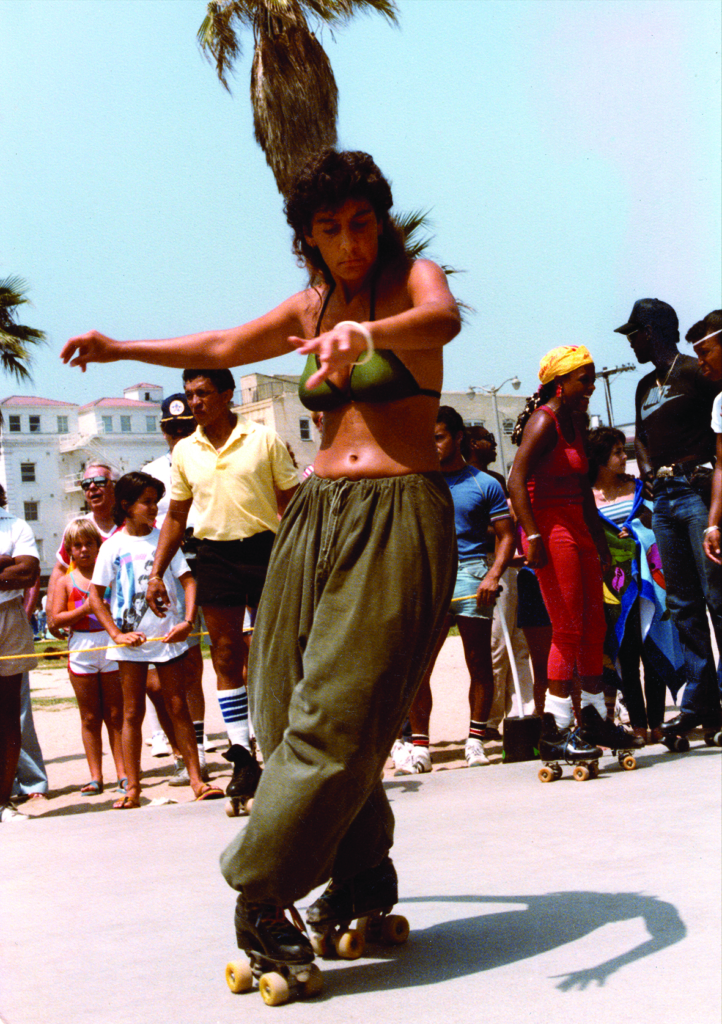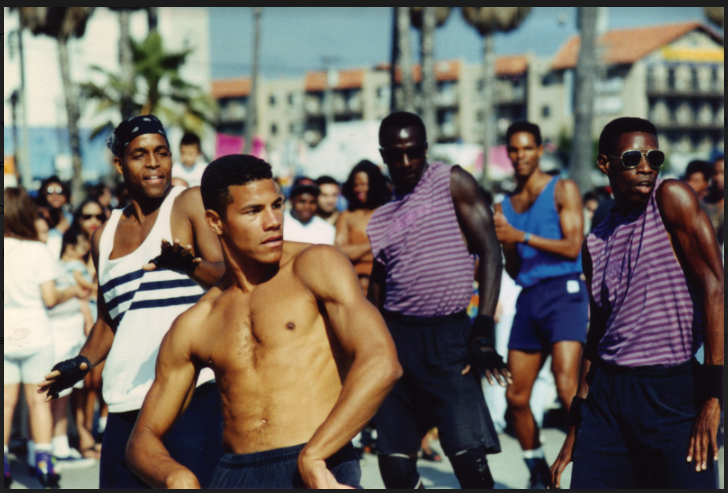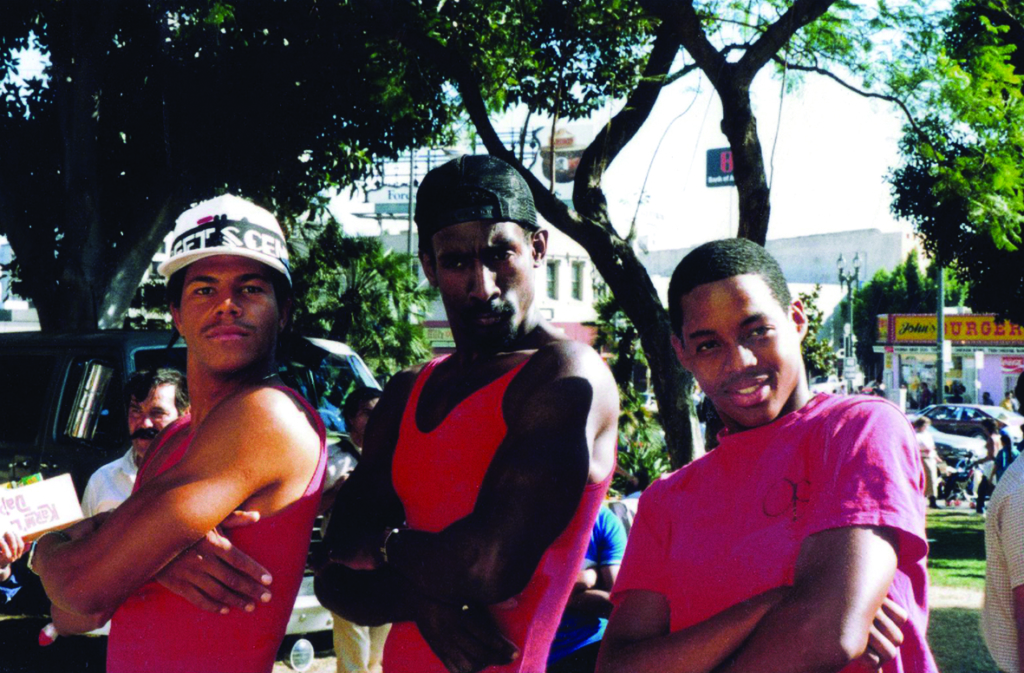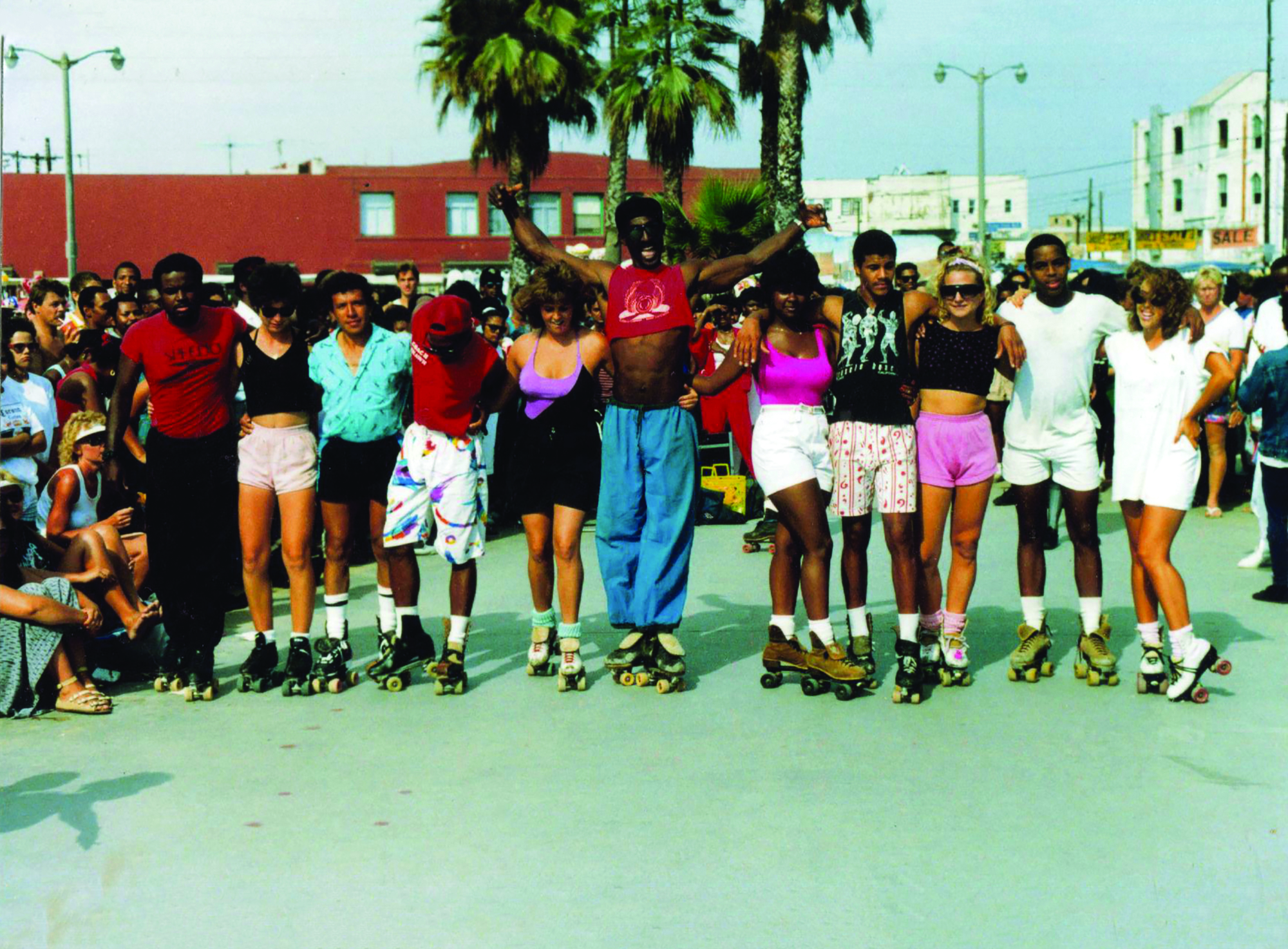When Roller Dreams (2017) skates across the screen, offering a chronicle of the roller-dancing scene in Los Angeles’ Venice Beach, it glides by on a memory and a question. The first film by Australian editor-turned-filmmaker Kate Hickey, the documentary can be traced back to her love of the Olivia Newton-John rollerskating movie Xanadu (Robert Greenwald, 1980) and her nostalgic desire to seek out the area that sparked the film – and the roller-dancing trend – when she first arrived in the US. Hickey didn’t find what she was expecting, however. Though a wave of late 1970s and early 1980s titles had featured roller dancing, what she saw was ‘[f]amiliar but markedly different too’, as she describes it in her director’s statement:
I was shocked to discover these were the original roller dancers who had inspired Xanadu, Skatetown, U.S.A. [William A Levey, 1979] and Roller Boogie [Mark L Lester, 1979], because [to] an outsider, they didn’t look anything like the hokey characters in the movies – they were mostly African American, male, and there wasn’t a leg warmer in sight.[1]Kate Hickey, ‘Director’s Statement’, in Aquarius Films, Roller Dreams press kit, 2017, p. 2.

Understanding why such a discrepancy exists – why the vision of roller dancing she’d seen on screen differed from the reality in front of her – became one of the primary motivating factors behind Roller Dreams. ‘I wanted to find out why these larger than life characters never made it onto my TV screen back in Australia,’ Hickey outlines.[2]ibid. This query underpins every frame of her documentary, tying into a broader conversation about what shapes expression and representation in US society as well as how both play out in American cinema.
In pursuit of answers, and in an effort to piece together a chronicle of a subculture rarely depicted on screen in its true form, Hickey allocates most of Roller Dreams’ running time to cutting between the past and the present. A wealth of vivid archival footage combines with frank contemporary interviews to paint a picture of the real Venice Beach roller-dancing scene and the real personalities behind it. Passion radiates in its period recordings from the late 1970s through to the early 1990s, as six key figures demonstrate their moves on the patch of concrete they considered their weekend home away from home. In recent discussions to-camera, the same figures reflect on the pastime they loved, on the reason they’re not included in glossy Hollywood renditions of it and on the paths their lives took after their community was torn apart.
Viewers meet James Lightning (aka Mad), the group’s leader, along with Sara Messenger (aka Sally Piano), his dance partner. Also sharing the spotlight are Terrell Ferguson, Larry Pitts, James ‘Jimmy’ Rich and Duval Stowers, who – whether donning superhero-inspired outfits, endeavouring to impress the ladies or discovering who they were – were also key members of the close-knit scene. Their enthusiasm isn’t just visible when they’re strutting their stuff in videos from their heyday, but also remains palpable in their smiles and glimmering eyes when they’re relaying their experiences to Hickey and her crew.
Coming through again and again in their to-camera missives is their love of roller dancing as a form of expression. It needn’t be said – the vision of the group taking to the pavement in their skates speaks volumes – but their words confirm what the viewer can already see.
Coming through again and again in their to-camera missives is their love of roller dancing as a form of expression. It needn’t be said – the vision of the group taking to the pavement in their skates speaks volumes – but their words confirm what the viewer can already see. As the film shows, personalities are shaped and solidified; identities, formed and forged; and confidence, found and won under the hot California sun as Mad, Sally Piano and the gang move to music, unleash their smooth choreography and enthral audiences that often flocked in the thousands.
‘I didn’t just want to do the routine – I wanted to be the routine,’ offers Mad, a sentiment echoed by his friends using their own turns of phrase. Swiftly, after luxuriating in its subjects’ joy, Roller Dreams begins to examine the meaning behind their statements, what the attention meant to them and how their roller-dancing prowess contrasted with their time away from the shore. Though the skaters hailed from different backgrounds and were ultimately on individual journeys, they were embraced by one another and by the crowds at one of Los Angeles’ (at the time) rare beaches that embraced a multicultural population. Terrell’s tough home situation in the Bloods-and Crips-dominated South Central LA, Sally Piano’s strict Middle Eastern upbringing and Mad’s constant run-ins with the law didn’t matter when they were gliding on eight wheels to songs such as James Brown’s anthemic ‘Say It Loud – I’m Black and I’m Proud’.
Alas, when Hollywood took an interest in roller dancing but refused to portray the largely African-American scene as it truly was, the community was starkly reminded of their outsider status beyond their happy turf. While they were asked to act as stand-ins and perform in skating scenes, it was in the name of exploiting their talent rather than providing the Venice Beach roller-dancing subculture an opportunity to shine. Mad recalls that he was even asked if his torso and head could be replaced with those of another actor – something that he would not approve.

As many of the skaters were well aware from their lives beyond their hobby, minorities being pushed aside by the rest of society wasn’t new. As films created on and about their turf piqued the public’s interest in roller dancing and Venice Beach, with it came a rise in prohibitive law enforcement. Slowly but certainly, the difficulties that many of the group experienced elsewhere infiltrated their weekend skating sessions; doing little to help their standing were the increased availability of drugs, the push for gentrification and the growing popularity of violent gangster rap over empowering soul and funk in the area. Restrictions were placed on the volume of their music and the hours it could be played, with the police subsequently attempting to push the skaters over to an uneven patch of ground. In the end, with the skaters refusing to acquiesce to arbitrary limitations, the asphalt they favoured was torn up.
Using the Watts and Rodney King riots to provide crucial, decades-spanning context, Roller Dreams adds a historical thrust to the present-day recollections of Mad, Sally Piano, Terrell, Larry, Jimmy and Duval. This turns the documentary into a scathing political statement, juxtaposing their previous desire to do what they loved with the treatment they received for pursuing it and the influence it had on their lives from that point forward. Many in the group still skate today, but few are enjoying the futures they’d dreamed of; the trajectories of some – including Mad, who escaped to a motorcycle club in Utah, and Sally Piano, who is poverty-stricken and resides in a garage – verge on heartbreaking. Hickey lets them recount their own tales, or fill in the gaps for one another, with the shadow of their happy past and the wounds inflicted by its sudden end ever-present.
In this way, Hickey ensures her film also acts as a dissection of the American dream, showing the difficulties faced by marginalised people as they endeavour to achieve it. In the skaters’ case, following their hearts became inseparable from struggles for expression and representation. The former was the primary thing that Mad and his friends sought: a way to be themselves, particularly within an accepting space that was far removed from life’s troubles. The latter, dashed by Hollywood and denied by the police and a changing Venice Beach community, was what they fought for but lost.
Hickey isn’t the first to make a connection between a minority group pursuing a specific pastime and their wider treatment within American society. Roller Dreams is strongly reminiscent of the similarly titled Hoop Dreams (1994), Steve James’ acclaimed basketball documentary that follows two black teenagers from underprivileged Chicago backgrounds as they try to turn their favourite sport into a career. James’ film chronicles the experiences of William Gates and Arthur Agee: one minute, they’re fourteen-year-olds playing ball every chance they can; next, they’re scouted to attend a mostly white private school in the suburbs. All the while, Hoop Dreams shows how the focus on training to win rather than playing for enjoyment has considerable repercussions; the resulting documentary is a damning interrogation of race, class and education, and the way these have dictated Gates’ and Agee’s futures. Like the Roller Dreams skaters, the boys see basketball as a means to express themselves and escape their surroundings, but they’re always at the mercy of a system that eschews giving them proper support and demands that they adhere to an established mould rather than live in an authentic fashion.

Two recent features focusing on dance also evoke similar themes. One fictional, one factual, The Fits (Anna Rose Holmer, 2015) and Step (Amanda Lipitz, 2017) both offer messages of hope rather than overt indictments of an oppressive society. Yet the need for the films’ respective central figures to find a way to express themselves and a place where they can do so is always apparent. In the first, an eleven-year-old is drawn to the world of dance, marking the first time the tomboy has connected with her female peers. In the second, a dance team from inner-city Baltimore trains and competes despite a number of its members grappling with the stresses of their final year of high school.
Paramount to both is the yearning to belong and the desire for visibility, specifically when home circumstances can’t fulfil those needs. While The Fits and Step maintain an overall sense of jubilance throughout their narratives, the underlying themes of race- and class-based marginalisation don’t escape notice – thereby linking them to Roller Dreams and Hoop Dreams. What does set Hickey’s and James’ films apart is their timeframe: whereas The Fits and Step restrict themselves to a small, discrete period – highlighting short-term positive outcomes without critiquing longer-term, systemic issues – Hoop Dreams and Roller Dreams reveal how complicated pasts are inextricably linked to far-from-rosy futures.
The legacy of Hoop Dreams and, now, Roller Dreams lies in the way they have exposed the struggle for expression and representation that remains even when skating, basketball or another pursuit patch over an oppressed group’s troubles or shine a light on new opportunities. Together, they lay bare some of the obstacles that continue to define – in the words of another James Brown song the Venice Beach gang likely roller-danced to – living in America.





